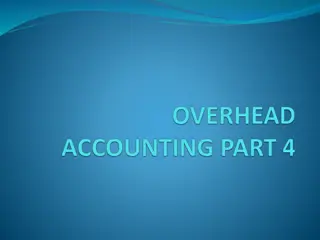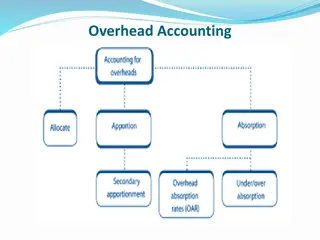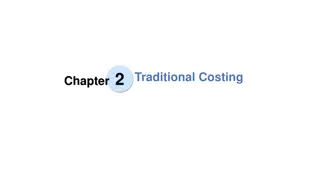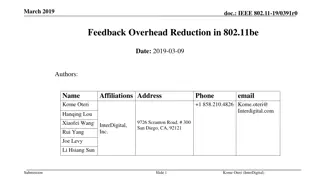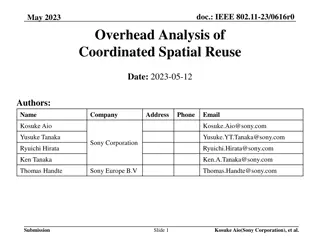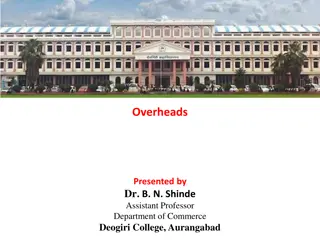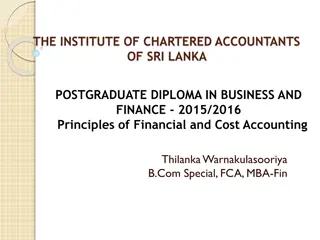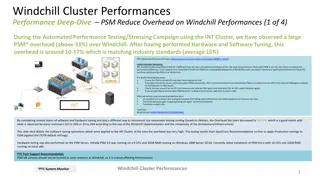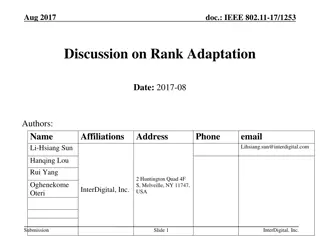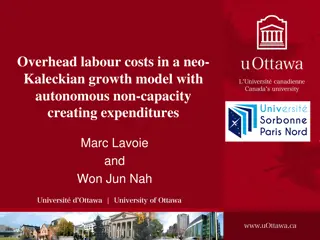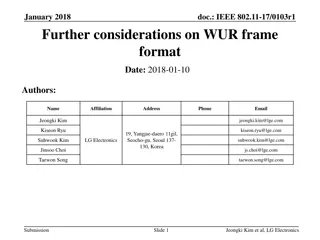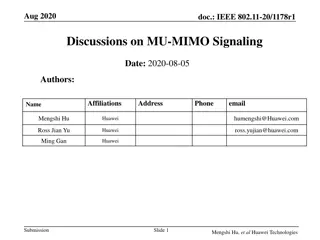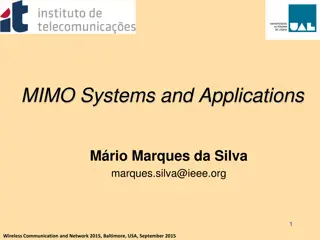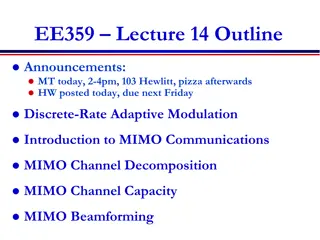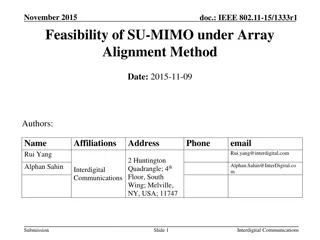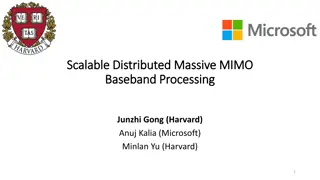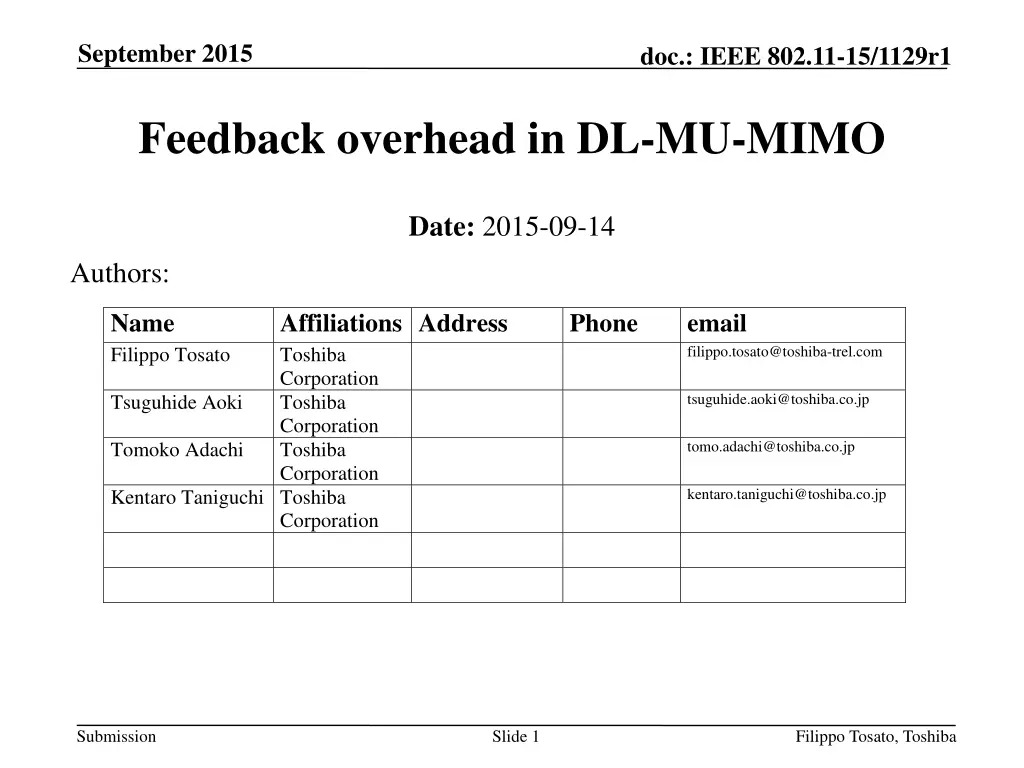
Improve Efficiency of MIMO Compressed Feedback Mechanism
Discuss the need to enhance the efficiency of MIMO compressed feedback in 11ax by reducing feedback overhead. The presentation focuses on improving CSI feedback for DL-MU-MIMO in IEEE 802.11 standards, addressing challenges like channel aging and feedback recurrence.
Download Presentation

Please find below an Image/Link to download the presentation.
The content on the website is provided AS IS for your information and personal use only. It may not be sold, licensed, or shared on other websites without obtaining consent from the author. If you encounter any issues during the download, it is possible that the publisher has removed the file from their server.
You are allowed to download the files provided on this website for personal or commercial use, subject to the condition that they are used lawfully. All files are the property of their respective owners.
The content on the website is provided AS IS for your information and personal use only. It may not be sold, licensed, or shared on other websites without obtaining consent from the author.
E N D
Presentation Transcript
September 2015 doc.: IEEE 802.11-15/1129r1 Feedback overhead in DL-MU-MIMO Date: 2015-09-14 Authors: Name Filippo Tosato Affiliations Address Toshiba Corporation Toshiba Corporation Toshiba Corporation Phone email filippo.tosato@toshiba-trel.com tsuguhide.aoki@toshiba.co.jp Tsuguhide Aoki tomo.adachi@toshiba.co.jp Tomoko Adachi kentaro.taniguchi@toshiba.co.jp Kentaro Taniguchi Toshiba Corporation Submission Slide 1 Filippo Tosato, Toshiba
September 2015 doc.: IEEE 802.11-15/1129r1 Abstract In this presentation we discuss the need to improve the efficiency of the MIMO compressed feedback mechanism in 11ax, when reporting more than 1 spatial vectors. This can be achieved based on the 11ac feedback format by reducing the number of quantised coefficients Submission Slide 2 Filippo Tosato, Toshiba
September 2015 doc.: IEEE 802.11-15/1129r1 Points of this presentation In 11ax the amount of CSI feedback needed for DL- MU-MIMO is likely to be larger than for 11ac Due to sensitivity to channel aging the recurrence in time of feedback reports in MU-MIMO is likely to be larger than for SU-MIMO Efficiency and performance can be improved by reducing the feedback overhead per CSI report and increase the occurrence of the reports Submission Slide 3 Filippo Tosato, Toshiba
September 2015 doc.: IEEE 802.11-15/1129r1 MIMO compressed feedback in 11ac STA ? measures the channel from the LTFs of the NDP and computes a beamforming feedback matrix for tone ?, ??,?, orthonormal column matrix of size ?? ??, from the SVD of the effective channel ????,?,?= ??,??? ????,?,?= ??,???,???,? Typically ??= ??? if the AP wants to sound the whole channel, i.e., one LTF per tx antenna ??,?is represented in compressed form by Givens rotations min{??,?? 1} ? ?? ?(???) ??? ?? ??(1? 1,????,?, ,????? 1,?) ? = ??? ?=?+1 ?=1 Submission Slide 4 Filippo Tosato, Toshiba
September 2015 doc.: IEEE 802.11-15/1129r1 MIMO compressed feedback in 11ac Givens representation of ? consists of ?? [0,2?) and ?? ??= ??(2?? ?? 1) NOTE: the number of real dimensions of ? is ??(2?? ??) but the feedback does not need to capture the absolute phase of the columns of ? The angles are uniformly quantised with the same resolution (2 more bits are needed for ? angles than ?) 2 angles {?} in 2 angles {?} in [0,?/2] with ? 4 6 7 9 ? 2 4 5 7 SU low-res SU high-res MU low-res MU high-res Submission Slide 5 Filippo Tosato, Toshiba
September 2015 doc.: IEEE 802.11-15/1129r1 SNR reporting in 11ac SNR is reported for each spatial stream ? 2 ????,?,?=[??,?]?,? ?0 Average SNR across the feedback tones, 8 bit uniform quantisation between -10dB and 53.75dB Delta SNR for each feedback tone, 4 bit uniform quantisation between - 8dB and 7dB Submission Slide 6 Filippo Tosato, Toshiba
September 2015 doc.: IEEE 802.11-15/1129r1 Feedback overhead in 11ax The amount of feedback in 11ax is likely to increase because 11ax may be used outdoors with higher channel frequency selectivity and Doppler spread, hence more reports are needed in frequency and time Multiple antenna terminals may become more widespread and reporting multiple spatial vectors more common DL-MU-MIMO is more sensitive to channel aging than SU-MIMO because of the residual interference across users and more frequent reports are needed. Efficiency and performance can be improved by reducing the amount of feedback in each report trading off part of this overhead reduction for more frequent reports, to lessen the effect of channel aging Submission Slide 7 Filippo Tosato, Toshiba
September 2015 doc.: IEEE 802.11-15/1129r1 Strategies to reduce feedback overhead Subcarrier grouping Increasing the group size may not be possible in very selective channels Differential feedback (e.g. reporting the difference between angles) + Can reduce overhead significantly Requires new type of feedback Reduce quantisation accuracy of {?} and {?} angles May lead to performance degradation Introduce a different CSI feedback mechanism, e.g. codebook based New CSI feedback format Poor accuracy Change the representation of the ? matrix by using fewer coefficients + The same feedback format as 11ac can be maintained + Significant overhead reduction when reporting >1 spatial vectors Submission Slide 8 Filippo Tosato, Toshiba
September 2015 doc.: IEEE 802.11-15/1129r1 Modified representation of ? A cosine-sine decomposition allows to represent the ? matrix with fewer quantised values 11ac compressed feedback START Input: ? START Input: ? Find CS Find Givens decomposition of ? decomposition of ? The feedback signals a linear combination of the 11ac spatial vectors ? Quantisation STOP Output quantised feedback Submission Slide 9 Filippo Tosato, Toshiba
September 2015 doc.: IEEE 802.11-15/1129r1 Summary Efficiency of the MIMO compressed feedback mechanism can be improved in 11ax by reducing the number of coefficients in the representation of the ? matrix The same feedback format can be maintained as in 11ax but the overhead is reduced for >1 feedback rank The overhead saving can be traded off for higher granularity of the feedback reports Submission Slide 10 Filippo Tosato, Toshiba
September 2015 doc.: IEEE 802.11-15/1129r1 Straw Poll Do you agree to add the following to the IEEE 802.11 TGax Specification Framework (sec 4.1)? The amendment shall define a mechanism to reduce the MIMO compressed beamforming feedback overhead to allow for more frequent reports in support of DL-MU- MIMO Y:N:A = Submission Slide 11 Filippo Tosato, Toshiba

